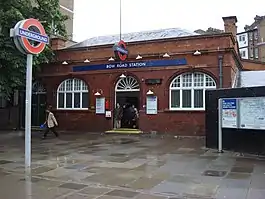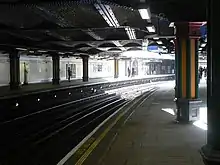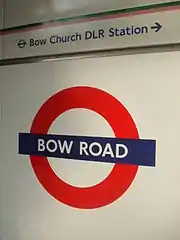Bow Road tube station
Bow Road is a London Underground station located on Bow Road in Bow, London, England. It is on the District and Hammersmith & City lines. The station is interlinked as an out of station interchange (OSI) with Bow Church station on the Docklands Light Railway which is about 300 m (980 ft) away via Bow Road. The two stations are classed as a single station for ticketing purposes as well as on tube maps but both managed separately.
| Bow Road | |
|---|---|
 | |
 Bow Road Location of Bow Road in Greater London | |
| Location | Bow |
| Local authority | London Borough of Tower Hamlets |
| Managed by | London Underground |
| Owner | Transport for London |
| Number of platforms | 2 |
| Fare zone | 2 |
| OSI | Bow Church |
| London Underground annual entry and exit | |
| 2015 | |
| 2016 | |
| 2017 | |
| 2018 | |
| 2019 | |
| Railway companies | |
| Original company | Whitechapel and Bow Railway |
| Key dates | |
| 11 June 1902 | Opened |
| 1950 | Ownership transferred to London Transport |
| Listed status | |
| Listing grade | II |
| Entry number | 1357787[5] |
| Added to list | 27 September 1973 |
| Other information | |
| External links | |
| WGS84 | 51.52722°N 0.02472°W |
Location
The station is situated on the road that reflects its own name, while a fire exit leads to Wellington Way. National rail c2c tracks and Mornington Grove road cross above the District line to the east of the platforms. Nearby landmarks include the Minnie Lansbury Memorial, Phoenix Primary and Secondary School, Thames Magistrates' Court, Bow Road police station and Tower Hamlets Cemetery Park. The station serves a medium-sized population, as part of its catchment overlaps Mile End station.[6]
History
The station was opened on 11 June 1902 by the Whitechapel and Bow Railway (which was later incorporated into the District line), with the Hammersmith & City line (then the Metropolitan line) following in 1936.
The Great Eastern Railway Bow Road railway station, which closed in 1949, stood on the opposite of Bow Road.
Ownership of the station passed to London Underground in 1950.[7]
Design and layout
_railway_station_1866821_ec289c7a.jpg.webp)
The station building is Grade II listed since 27 September 1973. Red bricks form the exterior facade, featuring stone eaves cornice and brick blocking course. The structure is topped with a slate roof, and has round arched doors. The doors are finished with fanlights, with four windows arranged alternately. An enclosed footbridge hangs across the platforms sheltered with canopies, both of which are made of wood. The canopies are barrel-vaulted, supported by cast iron beams and wall brackets, and hexagonal cast iron pillars. The pillars are arranged in line, following the curvature of the platforms. There are 12 pillars on one platform, while the other has 14.[5]

Bow Road station has two platforms, and marks the point where westbound trains from Upminster and Barking enter a tunnel; the gradient of the tunnel approach, which is to the east of the station, is 1 in 28, the steepest on the tube network.[8] The station platforms are below street level, where the western end of the platforms is in tunnel while the eastern end is in an open cutting.[6] Other stations on the District Line are designed in a similar way, such as High Street Kensington and Sloane Square.
Services and connections

Bow Road is served by both the District and Hammersmith & City lines, between Mile End and Bromley-by-Bow stations, in Travelcard Zone 2. Off-peak services on the District line generally run between Richmond or Ealing Broadway to Upminster. During peak hours, trains also operate to Wimbledon. The typical off-peak services, in trains per hour (tph) are:
- District line:[9]
- 12 tph eastbound to Upminster
- 6 tph westbound to Richmond
- 6 tph westbound Ealing Broadway
- Hammersmith & City line:[10]
- 6 tph eastbound to Barking
- 6 tph westbound to Hammersmith
London Buses services routes 25 and 205, local route 425, and night route N205 serve the station.[11]
Bow Road is connected east via thoroughfare of the same name to Bow Church station on the Docklands Light Railway (DLR) as an out of station interchange (OSI); classed as a single station for ticketing purposes but are managed as separate stations.[1]
References
- "Out-of-Station Interchanges" (Microsoft Excel). Transport for London. 2 January 2016. Retrieved 28 August 2016.
- "Multi-year station entry-and-exit figures (2007–2017)" (XLSX). London Underground station passenger usage data. Transport for London. January 2018. Retrieved 22 July 2018.
- "Station Usage Data" (CSV). Usage Statistics for London Stations, 2018. Transport for London. 21 August 2019. Retrieved 27 April 2020.
- "Station Usage Data" (XLSX). Usage Statistics for London Stations, 2019. Transport for London. 23 September 2020. Retrieved 9 November 2020.
- Historic England. "Details from listed building database (1357787)". National Heritage List for England. Retrieved 12 November 2012.
- "Bow Road tube station" (Map). Google Maps. Retrieved 6 February 2019.
- "Transport Act, 1947" (PDF). The London Gazette. 27 January 1950. p. 480. Retrieved 28 November 2012.
- "London Underground Statistics". trainweb.org. Retrieved 25 September 2012.
- Feather, Clive (17 September 2018). "District line". Clive's Underground Line Guides. Archived from the original on 3 April 2015. Retrieved 22 March 2015.
- Feather, Clive (16 November 2018). "Hammersmith & City line". Clive's Underground Line Guides. Archived from the original on 6 February 2019. Retrieved 6 February 2019.
- "Buses from Bow Church" (PDF). Transport for London. 17 June 2017. Archived from the original (PDF) on 6 February 2019. Retrieved 6 February 2019.
External links
| Wikimedia Commons has media related to Bow Road tube station. |
| Preceding station | Following station | |||
|---|---|---|---|---|
towards Hammersmith | Hammersmith & City line | towards Barking |
||
| District line | towards Upminster |
|||
| Former services | ||||
towards Hammersmith | Metropolitan line Hammersmith branch (1936-1990) | towards Barking |
||